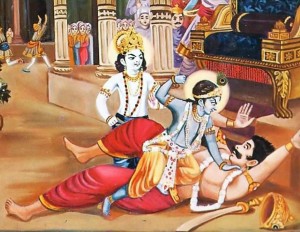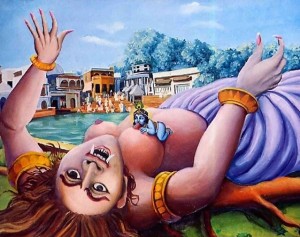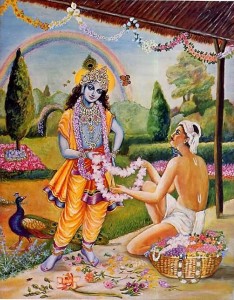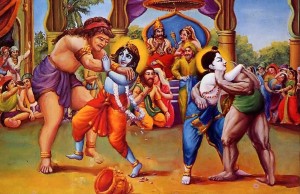by His Holiness Satsvarupa dasa Gosvami
BHAGAVAD-GITA states that Lord Krishna descends to this world to vanquish miscreants and rescue His devotees. Once when the world was overburdened with demoniac forces, the demigods prayed for the appearance of the Lord. Lord Krishna accepted the prayer, and He decided to appear as the son of two pure devotees, Vasudeva and his wife, Devaki. Years before Krishna’s actual advent, on the day Devaki and Vasudeva were married, Kamsa, the brother of the bride, was driving the couple to Vasudeva’s home. In the middle of the joyous procession, a voice suddenly rang out from the sky. “Kamsa,” the voice said, “you are such a fool! You are driving the chariot of your sister, but you do not know that the eighth child of your sister will kill you!”
Kamsa then at once took hold of Devaki and drew his sword to kill her. This shows the essence of Kamsa’s demoniac mentality: anyone or anything that threatened his bodily enjoyment must be destroyed. Vasudeva at once intervened and pleaded with Kamsa not to kill Devaki. Vasudeva spoke in a very enlightened way. Death, he told Kamsa, is inevitable, so why should we be afraid of it? After the end of this body, we get another body to fulfill our desires. Death is only a change of bodies. The real self is eternal, so we should try to find our real life beyond the body.
Unfortunately, Kamsa, being an atheist, could not listen to good instruction. Although each of us has but little control over the forces of nature, foolish people try to become lords of all they survey. They live only for the pleasure of the body, taking the body to be the self, and disregarding the soul. In ignorance, they say there is no soul.
This philosophy is now very popular, but it has existed since time immemorial. Thousands of years ago, in Vedic times, it was propounded by a philosopher named Carvaka, who taught that one should simply enjoy sensual pleasures, like eating, as much as he can. One should not hesitate to commit any irresponsible act to reach his goal, and one should not worry about the next life because at death everything will be finished. When modern so-called leaders take up this philosophy, people in general follow, and society becomes hellish. Not considering the will of the Supreme Personality of Godhead, or His supreme proprietorship, men take to animal slaughter, abortion, intoxication—anything. We are seeing only the beginning of this in current times. When Krishna conscious persons like Vasudeva try to give enlightenment, many so-called educated men take them lightly and say that the existence of God and the eternity of the soul are myths. And when governments also fail to meet their responsibility to further God consciousness, social degradation is assured.
 To dissuade Kamsa from murdering Devaki, Vasudeva promised that he and Devaki would bring Kamsa each of their children as they were born so that he could do what he liked with them. Kamsa relented, and when Vasudeva brought Kamsa their first-born child one year later, he became a little compassionate and spared the baby.
To dissuade Kamsa from murdering Devaki, Vasudeva promised that he and Devaki would bring Kamsa each of their children as they were born so that he could do what he liked with them. Kamsa relented, and when Vasudeva brought Kamsa their first-born child one year later, he became a little compassionate and spared the baby.
Later, however, Kamsa became alarmed when he heard from the sage Narada that Krishna was soon to appear. Narada told Kamsa that in his past life he had been a demon named Kalanemi, who had been killed by Lord Krishna, the Personality of Godhead. On hearing this, Kamsa foolishly became determined to kill the Lord. “Any child might be Krishna,” he concluded. He at once ordered the imprisonment of Vasudeva and Devaki and killed their child. Kamsa committed many other atrocities, all so that he might live and rule at any cost. He made alliances with many demoniac kings and imprisoned anyone who opposed him, including his own father, Ugrasena. In this way he expanded his kingdom, just as modern politicians do, until he became the strongest emperor of his time. He broke the solidarity of the Yadu dynasty, which included all of Krishna’s relatives, and forced them to hide in caves. Year after year Devaki gave birth to a child, and Kamsa murdered every one—six in all—fearing each to be the child who would kill him.
When Krishna Himself became the eighth child, He cheated Kamsa. He appeared before Vasudeva and Devaki as the Supreme Lord and then transformed Himself into a normal child. Krishna ordered Vasudeva to exchange Him with a female child just bom to mother Yasoda in nearby Gokula. Although Vasudeva was shackled and Kamsa’s prison well guarded, by Krishna’s mystic potency Vasudeva was able to escape from the prison, make the exchange, and return unnoticed to his cell.
Kamsa heard the cries of the newborn child as his death knell, and he rushed in to kill him. But the baby flew up into the air and assumed the form of the demigoddess Maya. “You rascal,” she said to Kamsa. “The child who will kill you has already been born elsewhere. You cannot kill Him.”
Threatened in this way, Kamsa and his demoniac associates began an all-out purge, ordering the murder of all male children born within the previous ten days. Kamsa also harassed all saintly persons and brahmanas. He knew that the devotees are the heart and soul of his enemy, Lord Krishna, so he tried to attack Him by persecuting His closest servitors and putting a stop to all religious activities.
Lord Krishna, however, was not at all fearful. He simply enjoyed His childhood pastimes in Vrndavana, giving pleasure to His friends, His mother and father, and the cowherd men and women. Kamsa, however, tried repeatedly to disrupt Krishna’s pastimes. First he sent a witch named Putana, who had already killed many babies by her black arts. She tried to kill Krishna when He was only a few months old. She smeared poison on her breast, appeared in Vrndavana as a beautiful young woman, and took permission from mother Yasoda to give Krishna her breast to suck. Baby Krishna, however, not only sucked her breast milk, but sucked out her life as well.

After Putana, Kamsa sent many demons, among them Trnavarta and Aghasura. Trnavarta appeared in the shape of a whirlwind and tried to kidnap Krishna and destroy Him high in the sky. Aghasura, the brother of Putana, came before Krishna and His friends as a giant serpent. But Krishna nonchalantly killed these ferocious demons one after another. Krishna’s father, Nanda, and other elders of the village were concerned about the constant attacks upon Krishna, so they moved their entire village community to a more suitable place, where they hoped to be free from attack. But more demons came; a giant horse, an enormous bull, a pack of asses, and many others. Child Krishna killed them all, assisted by His brother, Balarama.

When Krishna was sixteen years old, Kamsa discovered for certain that Krishna in Vrndavana was Devaki’s eighth child. Narada told Kamsa of Krishna’s true identity and related how He had killed all the demons without difficulty. In desperation, Kamsa formed his final plot: he arranged for a big wrestling match at Mathura and sent Akrura, Krishna’s uncle, to Vrndavana to invite Krishna and all His relatives and neighbors to attend the gala affair.
Akrura was actually a great devotee of Krishna. So when he arrived in Vrndavana, he confided to Krishna that the wrestling match was an elaborate plan to kill Him and His brother. Krishna and Balarama mildly laughed at this. They invited all the townsmen to go to Mathura, and They Themselves set out with Akrura.
Krishna’s arrival in Mathura was supposed to be His entrance into an ominous trap, but Krishna very blissfully and lightheartedly entered the city. And when the news spread that Krishna, the Supreme Personality of Godhead, had come, all the residents of Mathura spontaneously turned out to see Him. The real festival in Mathura became the festival of seeing Krishna. All the young girls were very eager to see Krishna, but out of modesty they went to the roofs of the houses to catch a glimpse of Him. The people had heard about Krishna and His activities, but only now did they have the chance to see Him. They became ecstatic and rushed from whatever they were doing to see Krishna passing through the streets. People talked back and forth about how beautiful Krishna was, and they praised the great fortune of the gopis and other devotees of Vrndavana who were able to see Krishna every day.
There are two kinds of human beings—devotees and demons—and in Mathura Krishna encountered both. While Krishna and Balarama were walking through the streets of Mathura, They met a washerman carrying various garments. Krishna asked the washerman for some clothing and promised to award him all good fortune. This is the basis of Krishna consciousness: the devotee offers whatever he has to the Lord, and the Lord, although not in need, accepts the offering to help awaken the devotee’s original relationship of service to Him. Unfortunately, this washerman thought himself a servant not of Krishna but of Kamsa. Not only did he refuse to give Krishna clothing, but he called Him impudent. “Don’t ask for things that are the King’s property,” he said, “or You will be punished.” Krishna became very angry with this servant of Kamsa and killed him, using only His hand as a weapon.

A little later Krishna and Balarama met a florist who was exactly the opposite of the washerman. He was very submissive and simply prayed to be eternally engaged in devotional service to Krishna. The florist gave Krishna a very beautiful garland at his home, and thus his desire was fulfilled.
Krishna and Balarama also met a young hunchback woman carrying sandalwood paste. Her duty had been to bring sandalwood to King Kamsa daily, but when she saw the personal beauty of Krishna and Balarama, she voluntarily offered the sandalwood paste to Them. In return, Krishna transformed her from a hunchback into a beautiful young woman by touching her with His hand. One may take these extraordinary encounters to be fictitious or imaginary, but they are the actual historic activities the Personality of Godhead performed while present on earth some 5,000 years ago. The great authorities in Krishna consciousness who are passing down the narrations of Bhagavad-gita and Srimad-Bhagavatam do not doubt these facts. Mundane scholars and people in general may doubt them, but they cannot understand the science of God as presented in Vedic literature. One who is not rendering service to the Personality of Godhead through a bona fide spiritual master can only whimsically speculate about what God can or cannot do.
As Krishna and Balarama approached the sacrificial arena in Mathura, They saw a big display where a giant bow was being guarded by state soldiers. Krishna walked right past the guards, picked up the bow and broke it. The sound of the bow’s cracking reverberated throughout the land and sky and even reached the palace of Kamsa. The guards rushed Krishna and Balarama, but the two brothers immediately killed them and left the arena.
Thereafter, Krishna continued to visit various places in Mathura, and the citizens turned out to see Him, astonished at His extraordinary beauty and opulence. In Krishna, the Supreme Personality of Godhead, Srila Prabhupada writes, “The two brothers strolled carefree in the street, not caring for the law and order of Kamsa.” In this way They hinted at the severe danger awaiting Kamsa.
When Kamsa heard the bow break and heard how the guards had been killed, he partially realized the power of the Supreme Lord. He understood that the eighth child of Devaki had come to kill him. That night he could not rest at all, for both awake and dreaming he had inauspicious visions. He looked in the mirror but could not see his head. He saw stars in the sky double. He saw holes in his shadow, heard a buzzing sound in his ears, and had ghastly dreams of ghosts, poison and murder. Thus he understood that his death was sure. But when morning finally came, he busily arranged for the wrestling match. In his last hours, with death so near, rather than pray to the Supreme Lord for mercy, Kamsa anxiously planned how to avert what he knew was certain.
All those who share Kamsa’s demoniac mentality are like that. They can see that material nature will eventually kill them, just as it has killed everyone else in history. Yet they act as if they will never die. A great devotee once called this the most wonderful phenomenon: people see the hand of death take away all their predecessors, but they think that they themselves will not die. The Kamsas of this world are always busy planning how to enjoy this life, even up till the second they are snatched away by death. So many modern cities have been built all over the world, but no one who lives in them has any guarantee that he won’t be kicked out today or tomorrow by death. Ignoring the next life only insures that we will have to take another birth to suffer miseries again and again. Kamsa was like a man trying to raise his temperature when he already has a high fever; when the fever reaches 107 degrees, a man dies. Kamsa could not see that all his plans to survive would be vanquished, nor did he care to hear about the next life. Like a typical politician, on the morning of his death Kamsa busied himself making plans for this temporary world.
 After bathing and performing other morning duties, Krishna and Balarama heard drums playing at the wrestling arena, and They prepared to go see the fun. But when They arrived at the gateway of the arena, a big elephant with a rider blocked Their path. This was another of Kamsa’s schemes. Krishna told the elephant’s caretaker to immediately clear the path, but the man became angry and provoked the elephant to charge Krishna. Krishna moved around the elephant, dragged it by its tail, tripped it and finally killed both the elephant and its rider.
After bathing and performing other morning duties, Krishna and Balarama heard drums playing at the wrestling arena, and They prepared to go see the fun. But when They arrived at the gateway of the arena, a big elephant with a rider blocked Their path. This was another of Kamsa’s schemes. Krishna told the elephant’s caretaker to immediately clear the path, but the man became angry and provoked the elephant to charge Krishna. Krishna moved around the elephant, dragged it by its tail, tripped it and finally killed both the elephant and its rider.
Krishna and Balarama then proceeded into the arena, where everyone at once became attracted to Them. The audience was completely attentive to Krishna and Balarama. The residents of Vrndavana were all reciting Their pastimes, and others, seeing Them for the first time, began to praise Their qualities.
Suddenly, a musical fanfare announced the start of the wrestling match. The famous champion wrestlers Canura and Mustika approached Krishna and Balarama, and Canura said, “We have heard all about You. The King desires to see You display Your wrestling abilities.” Krishna replied that although He and Balarama liked to play and sometimes They wrestled with Their cowherd friends, They were not professional wrestlers. Krishna said plainly that a match of” professional wrestlers against young boys would not be equal, and this would disturb the audience. But the wrestlers insisted that Krishna and Balarama were not ordinary boys, and so the match began.
Many members of the audience called out their disapproval, for Krishna and His brother appeared to be delicate boys of tender age, whereas the wrestlers were mountainous strongmen, trained in the art of crushing opponents. In Krishna, the Supreme Personality of Godhead, Srila Prabhupada specifically describes what the members of the audience said. “But my dear friends,” someone spoke out, “just look at the face of Krishna. There are drops of perspiration on His face from chasing His enemy, and His face appears like a lotus flower with drops of water. And do you see how the face of Lord Balarama has turned especially beautiful? There is a reddish hue on His white face because He is engaged in a strong wrestling match with Mustika.” Another spectator exclaimed, “Even in front of the King this wrestling match is going on between incompatible sides.” Thus the members of the audience were very attracted to Krishna, but at the same time they saw great danger and felt anxiety for Him. Even Krishna’s very intimate devotees, such as His mother and father, were also very anxious because they too did not know the unlimited strength of Krishna and Balarama.
Lord Krishna is actually all-powerful, and there is nothing to fear when He is fighting a conditioned living being of the material world. Krishna is declared throughout the Vedas to be the Absolute Truth, the source from whom everything comes and upon whom everything rests. Srimad-Bhagavatam says that He alone existed before creation. He is now the only ultimate reality, and after annihilation only He will remain. But by Krishna’s internal spiritual energy, called yoga-maya, He acts in different relationships with His servitors according to how they approach Him.
Krishna is the reservoir of all personal feelings, so we should not be surprised that He reveals Himself differently in various relationships. To the mass of people at the wrestling arena He appeared as the most beautiful personality, but to the wrestlers He appeared like a thunderbolt. The ksatriyas (warriors) saw Him as the strongest ruler, while the females saw Him as the most attractive male. The cowherd men from Vrndavana saw Him as their own kinsman, while the yogis saw Him as the Supersoul in everyone’s heart. Kamsa also saw Krishna uniquely—as Death Personified.
Kamsa was always fearful that Krishna would someday kill him. Thus he spent his whole life absorbed in thoughts of how to kill Krishna. Because he was always thinking of Krishna, Kamsa was Krishna conscious. But because he thought of Krishna unfavorably, he is not considered a devotee of the Lord. He was not practicing bhakti (devotional service). To be always thinking, like Kamsa, of how to avoid submitting to the Lord’s supreme will is the principal engagement of a whole class of men, including modern educators, scientists, politicians and philosophers. By hearing about Kamsa, we can clearly understand why such a mentality is self-defeating.

Krishna and Balarama engaged the wrestlers in the standard wrestling holds and maneuvers for some time, but when the anxious protests of the audience grew too great, Krishna simply spun one wrestler in the air, Balarama hit the other, and the famous wrestlers were dead. Other wrestlers came forward, but the two brothers killed them immediately, and the remaining wrestlers ran from the arena. Musicians spontaneously beat their drums, and the crowd cheered the victory of Krishna and Balarama.
Kamsa was enraged. He announced that Krishna and Balarama should be driven from the city of Mathura, Their riches plundered, and Krishna’s father killed. Krishna could not tolerate such talk. He jumped over the high wall protecting King Kamsa and stood before him face to face. Kamsa tried defending himself with a sword, but Krishna grabbed him and dragged him down from the throne. After throwing him on the ground, Krishna killed Kamsa by punching him with His fist. Krishna then dragged Kamsa around the arena the way a lion drags an elephant after killing it, just to assure His parents, relatives and all pious people that Kamsa was actually dead.
One may wonder why this narration contains so much violence and killing, since the Supreme Personality of Godhead is said to be all-merciful. But there is no question of wrongdoing in Krishna’s actions. Because Krishna is absolute, whatever Krishna does is absolutely good. Fighting and killing is required for a ksatriya (warrior) when there is a need to punish miscreants who threaten the peaceful citizens of society. When such criminals need to be rebuffed, nonviolence is cowardice, as Krishna told Arjuna on the Battlefield of Kuruksetra. Devotees of Krishna are naturally nonviolent toward all living entities, even animals, but if the demoniac make a violent disturbance, the devotees are prepared to counter such violence in the service of the Supreme Lord.
Also, when Krishna personally kills someone, He gives that person the benediction of liberation. Astoundingly, Kamsa was immediately awarded sarupya-mukti upon being killed by Krishna. This means that he went to the spiritual planets, where he was able to live in eternity, bliss and knowledge with a form almost exactly resembling the Supreme Lord’s in opulence and beauty. Such liberation is very difficult to achieve, even after hundreds of lifetimes spent searching for the Absolute Truth. Yogis and ascetics achieve release from all material desires only after prolonged, severe austerities. But even they do not reach the Vaikuntha planets; they merge into the impersonal brahmajyoti, the effulgence of the Lord. Kamsa, however, had a personal relationship with Krishna. He thought of Krishna day and night: “When will He come? What is He doing now? When will He kill me?” So Kamsa was given a place more exalted than all the impersonal mystic yogis of the hatha-yoga school or the philosophers who speculate about the impersonal Absolute Truth. This gives a hint of the great power of bhakti. If an avowed enemy of Krishna is given such a high place, we can barely even imagine the sweet favor the Lord awards to those who relate to Him in a positive, loving way, always rendering service to Him and chanting His glories.
Finally, one might ask why Krishna should personally fight with a demon like Kamsa. Krishna, being the source of all emanations and qualities, has His own transcendental desires. Therefore He also has a fighting propensity, which He exhibits in His playful wrestling with the cowherd boys of Vrndavana. Authorities in the science of Krishna consciousness inform us that Krishna’s choice to fight with Kamsa indicates that Kamsa is actually a liberated devotee of Krishna’s who was sent to the material world to provide the Lord a suitable opponent. Kamsa could not actually threaten Krishna; Krishna arranged the fight for His personal pleasure. This understanding brings us to a level of consciousness beyond violence or nonviolence, morality or immorality.
Krishna displays His eternal pastimes with His devotees just to attract us to return to His loving service. We are all eternal parts and parcels of Krishna, but we are now suffering the miseries of repeated birth and death in the material world, in forgetfulness of Krishna. We should not struggle to rival Krishna; rather, we should understand that the only business of our life is to serve the Lord. We each have a natural aptitude for the service of Krishna, and that should be developed, under the guidance of a bona fide spiritual master. The first engagement is to hear the pastimes of Krishna. Our present age is very fallen, full of materialistic and impersonal concepts of reality, but the truth is available in the vast treasurehouse of Vedic literature. The sincere seeker will find that truth very easily, if he begins with a submissive ear.
His Holiness Satsvarupa dasa Gosvami has served as President of ISKCON’s Boston Temple, as Editor of Back to Godhead and, most recently, as personal secretary to Srila Prabhupada, the founder-acarya of the Hare Krishna movement. He is now traveling in the United States, distributing Krishna conscious literature to libraries and college professors.

Leave a Reply